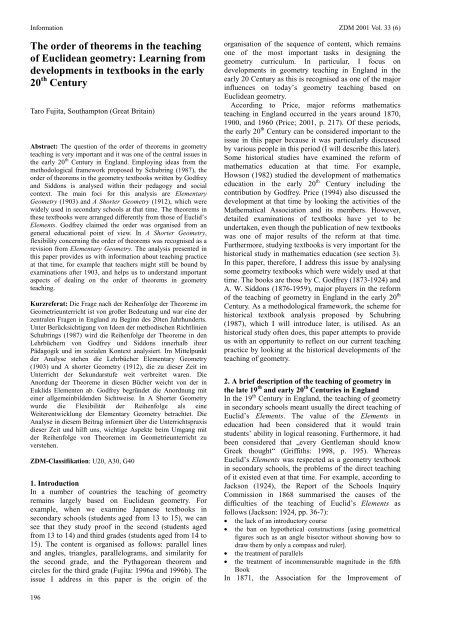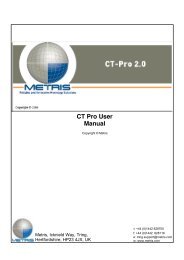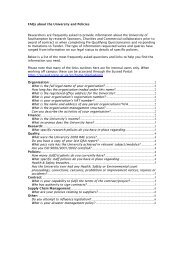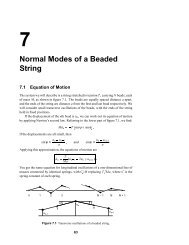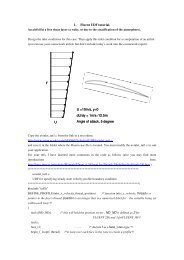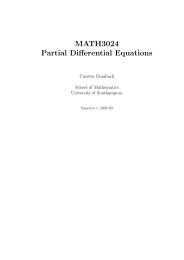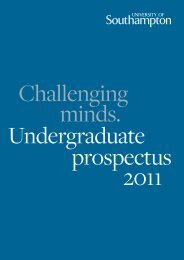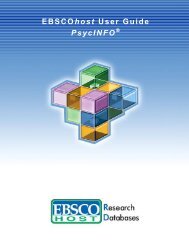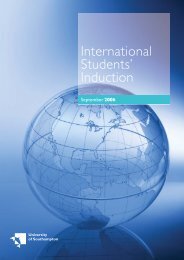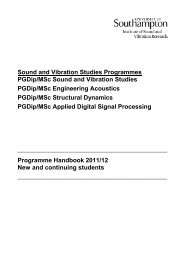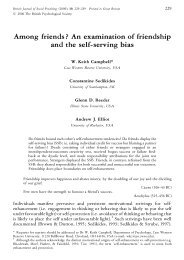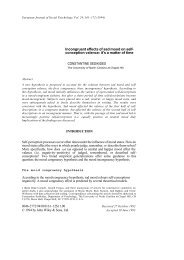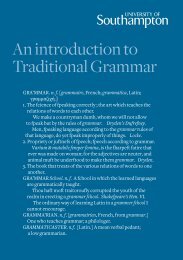1. Introduction - University of Southampton
1. Introduction - University of Southampton
1. Introduction - University of Southampton
Create successful ePaper yourself
Turn your PDF publications into a flip-book with our unique Google optimized e-Paper software.
Information ZDM 2001 Vol. 33 (6)<br />
The order <strong>of</strong> theorems in the teaching<br />
<strong>of</strong> Euclidean geometry: Learning from<br />
developments in textbooks in the early<br />
20 th Century<br />
Taro Fujita, <strong>Southampton</strong> (Great Britain)<br />
Abstract: The question <strong>of</strong> the order <strong>of</strong> theorems in geometry<br />
teaching is very important and it was one <strong>of</strong> the central issues in<br />
the early 20 th Century in England. Employing ideas from the<br />
methodological framework proposed by Schubring (1987), the<br />
order <strong>of</strong> theorems in the geometry textbooks written by Godfrey<br />
and Siddons is analysed within their pedagogy and social<br />
context. The main foci for this analysis are Elementary<br />
Geometry (1903) and A Shorter Geometry (1912), which were<br />
widely used in secondary schools at that time. The theorems in<br />
these textbooks were arranged differently from those <strong>of</strong> Euclid’s<br />
Elements. Godfrey claimed the order was organised from an<br />
general educational point <strong>of</strong> view. In A Shorter Geometry,<br />
flexibility concerning the order <strong>of</strong> theorems was recognised as a<br />
revision from Elementary Geometry. The analysis presented in<br />
this paper provides us with information about teaching practice<br />
at that time, for example that teachers might still be bound by<br />
examinations after 1903, and helps us to understand important<br />
aspects <strong>of</strong> dealing on the order <strong>of</strong> theorems in geometry<br />
teaching.<br />
Kurzreferat: Die Frage nach der Reihenfolge der Theoreme im<br />
Geometrieunterricht ist von großer Bedeutung und war eine der<br />
zentralen Fragen in England zu Beginn des 20ten Jahrhunderts.<br />
Unter Berücksichtigung von Ideen der methodischen Richtlinien<br />
Schubrings (1987) wird die Reihenfolge der Theoreme in den<br />
Lehrbüchern von Godfrey und Siddons innerhalb ihrer<br />
Pädagogik und im sozialen Kontext analysiert. Im Mittelpunkt<br />
der Analyse stehen die Lehrbücher Elementary Geometry<br />
(1903) und A shorter Geometry (1912), die zu dieser Zeit im<br />
Unterricht der Sekundarstufe weit verbreitet waren. Die<br />
Anordung der Theoreme in diesen Bücher weicht von der in<br />
Euklids Elementen ab. Godfrey begründet die Anordnung mit<br />
einer allgemeinbildenden Sichtweise. In A Shorter Geometry<br />
wurde die Flexibilität der Reihenfolge als eine<br />
Weiterentwicklung der Elementary Geometry betrachtet. Die<br />
Analyse in diesem Beitrag informiert über die Unterrichtspraxis<br />
dieser Zeit und hilft uns, wichtige Aspekte beim Umgang mit<br />
der Reihenfolge von Theoremen im Geometrieunterricht zu<br />
verstehen.<br />
ZDM-Classifikation: U20, A30, G40<br />
<strong>1.</strong> <strong>Introduction</strong><br />
In a number <strong>of</strong> countries the teaching <strong>of</strong> geometry<br />
remains largely based on Euclidean geometry. For<br />
example, when we examine Japanese textbooks in<br />
secondary schools (students aged from 13 to 15), we can<br />
see that they study pro<strong>of</strong> in the second (students aged<br />
from 13 to 14) and third grades (students aged from 14 to<br />
15). The content is organised as follows: parallel lines<br />
and angles, triangles, parallelograms, and similarity for<br />
the second grade, and the Pythagorean theorem and<br />
circles for the third grade (Fujita: 1996a and 1996b). The<br />
issue I address in this paper is the origin <strong>of</strong> the<br />
organisation <strong>of</strong> the sequence <strong>of</strong> content, which remains<br />
one <strong>of</strong> the most important tasks in designing the<br />
geometry curriculum. In particular, I focus on<br />
developments in geometry teaching in England in the<br />
early 20 Century as this is recognised as one <strong>of</strong> the major<br />
influences on today’s geometry teaching based on<br />
Euclidean geometry.<br />
According to Price, major reforms mathematics<br />
teaching in England occurred in the years around 1870,<br />
1900, and 1960 (Price; 2001, p. 217). Of these periods,<br />
the early 20 th Century can be considered important to the<br />
issue in this paper because it was particularly discussed<br />
by various people in this period (I will describe this later).<br />
Some historical studies have examined the reform <strong>of</strong><br />
mathematics education at that time. For example,<br />
Howson (1982) studied the development <strong>of</strong> mathematics<br />
education in the early 20 th Century including the<br />
contribution by Godfrey. Price (1994) also discussed the<br />
development at that time by looking the activities <strong>of</strong> the<br />
Mathematical Association and its members. However,<br />
detailed examinations <strong>of</strong> textbooks have yet to be<br />
undertaken, even though the publication <strong>of</strong> new textbooks<br />
was one <strong>of</strong> major results <strong>of</strong> the reform at that time.<br />
Furthermore, studying textbooks is very important for the<br />
historical study in mathematics education (see section 3).<br />
In this paper, therefore, I address this issue by analysing<br />
some geometry textbooks which were widely used at that<br />
time. The books are those by C. Godfrey (1873-1924) and<br />
A. W. Siddons (1876-1959), major players in the reform<br />
<strong>of</strong> the teaching <strong>of</strong> geometry in England in the early 20 th<br />
Century. As a methodological framework, the scheme for<br />
historical textbook analysis proposed by Schubring<br />
(1987), which I will introduce later, is utilised. As an<br />
historical study <strong>of</strong>ten does, this paper attempts to provide<br />
us with an opportunity to reflect on our current teaching<br />
practice by looking at the historical developments <strong>of</strong> the<br />
teaching <strong>of</strong> geometry.<br />
2. A brief description <strong>of</strong> the teaching <strong>of</strong> geometry in<br />
the late 19 th and early 20 th Centuries in England<br />
In the 19 th Century in England, the teaching <strong>of</strong> geometry<br />
in secondary schools meant usually the direct teaching <strong>of</strong><br />
Euclid’s Elements. The value <strong>of</strong> the Elements in<br />
education had been considered that it would train<br />
students’ ability in logical reasoning. Furthermore, it had<br />
been considered that „every Gentleman should know<br />
Greek thought“ (Griffiths: 1998, p. 195). Whereas<br />
Euclid’s Elements was respected as a geometry textbook<br />
in secondary schools, the problems <strong>of</strong> the direct teaching<br />
<strong>of</strong> it existed even at that time. For example, according to<br />
Jackson (1924), the Report <strong>of</strong> the Schools Inquiry<br />
Commission in 1868 summarised the causes <strong>of</strong> the<br />
difficulties <strong>of</strong> the teaching <strong>of</strong> Euclid’s Elements as<br />
follows (Jackson: 1924, pp. 36-7):<br />
• the lack <strong>of</strong> an introductory course<br />
• the ban on hypothetical constructions [using geometrical<br />
figures such as an angle bisector without showing how to<br />
draw them by only a compass and ruler].<br />
• the treatment <strong>of</strong> parallels<br />
• the treatment <strong>of</strong> incommensurable magnitude in the fifth<br />
Book<br />
In 1871, the Association for the Improvement <strong>of</strong><br />
196
ZDM 2001 Vol. 33 (6)<br />
Geometrical Teaching (the AIGT) was founded by<br />
<strong>University</strong> mathematicians and teachers from public<br />
schools to improve the teaching <strong>of</strong> geometry. To <strong>of</strong>fer an<br />
alternative to Euclid’s Elements, the methods <strong>of</strong> pro<strong>of</strong><br />
and the order <strong>of</strong> theorems were discussed by the members<br />
<strong>of</strong> this association. The AIGT published its Syllabus <strong>of</strong><br />
Plane Geometry in 1875 and then, in 1884 and 1886,<br />
published a geometry textbook, The Elements <strong>of</strong> Plane<br />
Geometry which included pro<strong>of</strong>s <strong>of</strong> the theorems<br />
contained in the syllabus <strong>of</strong> 1875. The Elements <strong>of</strong> Plane<br />
Geometry „whilst retaining Euclid’s overall sequence,<br />
rearranged theorems within allied groups and supplied<br />
new pro<strong>of</strong>s“ (Howson: 1973b, p. 158). However, these<br />
efforts failed to change the teaching <strong>of</strong> geometry, partly<br />
because A. Cayley, who was the most powerful<br />
Cambridge mathematician at that time, opposed radical<br />
reform, and more importantly, the Examination Boards<br />
such as Oxford and Cambridge were reluctant to revise<br />
their examination requirements (Siddons: 1936, p. 18,<br />
Griffiths: 1998, p. 196).<br />
In 1901 J. Perry, Pr<strong>of</strong>essor <strong>of</strong> Engineering at the Royal<br />
College <strong>of</strong> Science, gave an address „The Teaching <strong>of</strong><br />
Mathematics“ at the British Association for the<br />
Advancement <strong>of</strong> Science (the BAAS) meeting in<br />
Glasgow. In the address, he denounced contemporary<br />
mathematics teaching. With regard to the teaching <strong>of</strong><br />
geometry, he questioned the educational value <strong>of</strong><br />
Euclidean geometry for all students, and emphasised the<br />
value <strong>of</strong> the introduction <strong>of</strong> experimental tasks in the<br />
early stages (Perry, 1902: pp. 158-81). As a consequence<br />
<strong>of</strong> this address, various movements by organisations and<br />
individuals occurred aimed at reforming the teaching <strong>of</strong><br />
geometry. In the Annual Meeting <strong>of</strong> the Mathematical<br />
Association (the MA) (the AIGT changed its name to the<br />
Mathematical Association in 1897) in 1902, the issue<br />
„the reform <strong>of</strong> geometry“ was discussed by members. It<br />
was suggested by some members that the order in the<br />
teaching <strong>of</strong> geometry be rearranged in „a more natural<br />
order“ (MA: 1902a, pp. 129-43). They did not expand on<br />
what they meant by this nor did they propose a particular<br />
order. Suggestions from „the teaching <strong>of</strong> mathematics in<br />
public schools (the letter <strong>of</strong> the 22 school masters)“ and<br />
„the MA Report on Geometry in 1902“ were rather<br />
modest. They stated that they still respected Euclid’s<br />
order (Godfrey and Siddons et at: 1902, MA: 1902b, pp.<br />
168-72). Nevertheless, in the BAAS Report on the<br />
Teaching <strong>of</strong> Mathematics, it was suggested that Euclid’s<br />
order was not suitable for the teaching <strong>of</strong> geometry<br />
(BAAS: 1902, pp. 197-201).<br />
As a result <strong>of</strong> these movements, Oxford and Cambridge<br />
Universities finally revised their examination<br />
requirements in 1903. For example, the examination<br />
syndicate <strong>of</strong> Cambridge <strong>University</strong> stated that: „in<br />
demonstrative geometry, Euclid’s Elements shall be<br />
optional as a text-book, and the sequence <strong>of</strong> Euclid shall<br />
not be enforced. The Examiners will accept any pro<strong>of</strong> <strong>of</strong><br />
a proposition which they are satisfied forms part <strong>of</strong><br />
systematic treatment <strong>of</strong> the subject“ (The Examination<br />
Syndicate: 1903, p. 179). Hence, the teaching <strong>of</strong><br />
geometry was released from strict adherence to Euclid’s<br />
Elements and teachers had the freedom to organise a<br />
different geometry curriculum for students. In the next<br />
Information<br />
section, before examining the order <strong>of</strong> theorems in<br />
geometry textbooks, I outline the methodology for<br />
systematically analysing textbooks.<br />
3. Methodology<br />
3.<strong>1.</strong> Schubring’s three-dimensional textbook analysis<br />
To study school life in the past in more detail, Schubring<br />
proposes the study <strong>of</strong> the textbook authors and their<br />
oeuvre, i.e. textbooks, because school textbooks are <strong>of</strong>ten<br />
revised and therefore examining their revisions would<br />
give us various information about changing trends and<br />
ideas in teaching:<br />
„In fact, investigating the personality <strong>of</strong> a schoolbook author<br />
and the totality <strong>of</strong> his oeuvre can enable us to get insight into the<br />
social meaning <strong>of</strong> school knowledge and <strong>of</strong> the relations<br />
between the author and his „clients“: the teachers. As<br />
schoolbooks are usually reedited [re-edited] several times and<br />
during this time undergo substantial changes, one can put in<br />
relation changes in the textbook and changes in the school<br />
structure, changes in the social appreciation <strong>of</strong> school<br />
knowledge and the active or passive reactions <strong>of</strong> the school<br />
book author to these changes. Thus, choosing the work <strong>of</strong> one<br />
schoolbook author as a basic unit may be one approach by<br />
which one can better analyse the reality <strong>of</strong> school life in former<br />
days.“ (Schubring: 1987, p. 41)<br />
To analyse textbooks with their social context, Schubring<br />
proposed a three-dimensional scheme for the<br />
methodology <strong>of</strong> textbook analysis (Schubring: 1987, p.<br />
45):<br />
• the first dimension consists <strong>of</strong> analysing the changes within<br />
the various editions <strong>of</strong> one textbook chosen as starting<br />
point, say an algebra textbook or an arithmetic one:<br />
• the next dimension consists in finding corresponding<br />
changes in other textbooks belonging to the same oeuvre, by<br />
studying those parts dealing with related conceptual fields,<br />
say geometrical algebra, trigonometry, etc.,<br />
• the third dimension relates the changes in the textbooks to<br />
changes in the context: changes in the syllabus, ministerial<br />
decrees, didactical debates, evolution <strong>of</strong> mathematics,<br />
changes in epistemology, etc.<br />
3.2. Methodology in this paper<br />
The subject in this paper is the geometry textbooks by<br />
Godfrey and Siddons, representative textbook authors at<br />
that time (Howson: 1973b and 1982, Price: 1976,<br />
Griffiths: 1998). The major geometry textbooks by<br />
Godfrey and Siddons, which were published by<br />
Cambridge <strong>University</strong> Press, are as follows:<br />
• Elementary Geometry Practical and Theoretical<br />
(1903)<br />
• Modern Geometry (1908)<br />
• A Shorter Geometry (1912)<br />
• Practical and Theoretical Geometry (1920)<br />
These textbooks are all for secondary schools, except<br />
Modern Geometry, which „covers the schedule <strong>of</strong><br />
Modern Plane Geometry required for the Special<br />
Examination in Mathematics for the Ordinary B.A.<br />
Degree at Cambridge“ (Godfrey and Siddons: 1908,<br />
Preface). Of these textbooks, Elementary Geometry was<br />
especially significant. It was their first textbook and<br />
considered one <strong>of</strong> the most important in the history <strong>of</strong> the<br />
197
Information ZDM 2001 Vol. 33 (6)<br />
teaching <strong>of</strong> geometry in England, as the comments below,<br />
beginning with one from Howson, demonstrate:<br />
„One book, though, had a far from temporary effect – Godfrey<br />
and Siddons“ Elementary geometry … Elementary geometry<br />
was an indication <strong>of</strong> the way in which the two authors saw<br />
mathematical education progressing.“ (Howson: 1973b, p. 259)<br />
A review <strong>of</strong> Elementary Geometry (1903) by Langley<br />
was reprinted in the Mathematical Gazette Vol. LV. No.<br />
392, a celebration <strong>of</strong> the centenary <strong>of</strong> the MA in 197<strong>1.</strong><br />
From 1894 to 1931, a total <strong>of</strong> 1834 mathematics books<br />
were reviewed in the Mathematical Gazette (The MA:<br />
1933). That the review <strong>of</strong> Elementary Geometry was<br />
chosen among only 7 to be reprinted in 1971 is an<br />
illustration <strong>of</strong> its hallowed status. It is clear, then, why it<br />
is necessary to study Elementary Geometry in particular.<br />
Now, borrowing ideas from Schubring’s model, in<br />
particular the second and third dimensions, I introduce<br />
the method <strong>of</strong> the analysis <strong>of</strong> geometry textbook by<br />
Godfrey and Siddons. First, I analyse Elementary<br />
Geometry. The order <strong>of</strong> theorems <strong>of</strong> this text is described<br />
by comparing it to Todhunter’s The Elements <strong>of</strong> Euclid<br />
(1862), which was an English translation <strong>of</strong> Euclid’s<br />
Elements as well as a textbook widely used in the 19 th<br />
Century in England. Secondly, I examine the order in A<br />
Shorter Geometry, their second geometry textbook, and<br />
then describe the revisions from Elementary Geometry.<br />
Finally I discuss particularly two points: the pedagogical<br />
background <strong>of</strong> Godfrey and Siddons and the revisions<br />
recognised in A Shorter Geometry and their context. The<br />
order <strong>of</strong> theorems is an important issue, and therefore, I<br />
concentrate in this paper on the order <strong>of</strong> theorems in these<br />
two textbooks, i.e. the period between 1903 to 1912.<br />
4. The order <strong>of</strong> theorems in the textbooks by Godfrey<br />
and Siddons<br />
4.<strong>1.</strong> The order <strong>of</strong> theorems in Elementary Geometry<br />
While the 20 th century reform <strong>of</strong> the teaching <strong>of</strong> geometry<br />
was just beginning, Forsyth, who was the Sadleirian<br />
Pr<strong>of</strong>essor at Cambridge, suggested that Godfrey and<br />
Siddons write a new geometry textbook for secondary<br />
schools. Historically, the proposal <strong>of</strong> Forsyth to Godfrey<br />
and Siddons had a significant meaning, because he was a<br />
successor <strong>of</strong> Cayley, who had strongly opposed the<br />
radical reform <strong>of</strong> the teaching <strong>of</strong> geometry until his death<br />
in 1895 (Price: 1994, p. 30). The following extract is<br />
from Siddons’ memoirs in 1952:<br />
„While Godfrey and I [Siddons] were at the British Association<br />
meeting at Belfast in September 1902 we received word from<br />
Forsyth that the Syndicate <strong>of</strong> the Cambridge <strong>University</strong> Press<br />
would invite us to write an Elementary Geometry and at the<br />
same time he advised us to ignore Euclid’s order.“ (Siddons:<br />
1952, p. 6)<br />
It is this reform <strong>of</strong> Euclid’s order that is particularly<br />
important because it means that authors were released<br />
from following a given structure and had the freedom to<br />
write a textbook as they felt appropriate. In 1903<br />
Elementary Geometry was published and was<br />
immediately a great success: „13000 [copies] <strong>of</strong> the<br />
complete book and 9000 <strong>of</strong> Volume I in the first ten<br />
months. A further 8000 <strong>of</strong> the complete book and 3500 <strong>of</strong><br />
Volume I followed in the next twelve months.“ (Siddons:<br />
1952, p. 9).<br />
Elementary Geometry consists <strong>of</strong> two parts: Part I.<br />
‘Experimental Geometry’ and Part II. ‘Theoretical<br />
Geometry’. ‘Experimental geometry’ mainly contains<br />
experimental tasks such as measurement or drawing<br />
dealing with both plane and solid figures. The purposes<br />
<strong>of</strong> this stage are a) to make students familiar with<br />
geometrical instruments and figures and b) to lead<br />
students to discover geometrical facts (a detailed<br />
examination <strong>of</strong> the roles <strong>of</strong> experimental tasks in<br />
Elementary Geometry can be found in Fujita: 2001).<br />
Nevertheless, ‘Theoretical geometry’ consisted <strong>of</strong><br />
propositions from Euclid’s Elements with four continuous<br />
books: Book I: Straight lines, Book II: Areas, Book III:<br />
Circles, and Book IV Similarity. It should be noted that<br />
some experimental tasks also appeared in ‘Theoretical<br />
Geometry’. Also, the use <strong>of</strong> squared paper was<br />
implemented in this textbook. The activities required in<br />
exercises were plotting points, drawing figures and<br />
similar figures, finding areas and ratios <strong>of</strong> figures, and<br />
plotting loci on squared paper.<br />
The question considered in this paper is how the order<br />
<strong>of</strong> theorems was rearranged from the order in Euclid’s<br />
Elements. In what follows, I particularly focus on the<br />
order <strong>of</strong> Books I&II in Elementary Geometry, whose<br />
content corresponds to Books I&II in Euclid’s Elements.<br />
Tables 4.<strong>1.</strong><strong>1.</strong> and 4.<strong>1.</strong>2. summarise the order <strong>of</strong> theorems<br />
in Books I&II in Elementary Geometry (in the tables,<br />
‘Euclid Book I (II)’, ‘Proposition in Euclid’ are<br />
abbreviated ‘Euc. I. (II.)’ and ‘Prop.’ respectively)<br />
Table 4.<strong>1.</strong>1: The order <strong>of</strong> theorems in Book I Elementary<br />
Geometry<br />
Sections in<br />
Euclid’s Elements<br />
Elementary Geometry (Todhunter’s edition)<br />
Angles at a point Euc. I. Prop. 13, 14, 15<br />
Parallel straight lines Euc. I. Prop. 27, 28, 29, 30<br />
Angles <strong>of</strong> a triangle, a Euc. I. Prop. 32, 16, 17<br />
polygon<br />
Classification <strong>of</strong> No Euclid propositions<br />
triangles<br />
Congruent triangles Euc. I. Prop. 4, 26, 5, 6, 8<br />
Constructions Euc. I. 22, 23, 9, 10, 11, 12<br />
Inequalities Euc. I. Prop. 18, 19, 20, 24, 25<br />
Parallelograms Euc. Prop. 34, 31<br />
Subdivision <strong>of</strong> a straight<br />
line<br />
No Euclid propositions<br />
(1 theorem and 1 construction)<br />
Loci<br />
No Euclid propositions<br />
(2 theorems)<br />
Co-ordinates<br />
No Euclid propositions<br />
Table 4.<strong>1.</strong>2: The order <strong>of</strong> theorems in Book II Elementary<br />
Geometry<br />
Sections in<br />
Euclid’s Elements<br />
(Todhunter’s edition)<br />
Elementary Geometry<br />
Area <strong>of</strong> parallelogram Euc. I. 35, 36<br />
Area <strong>of</strong> triangle Euc. I. 37, 38<br />
Area <strong>of</strong> polygon Euc. I. 39, 40, 41<br />
The theorem <strong>of</strong><br />
Pythagoras<br />
Illustrations <strong>of</strong><br />
Euc. I. 47, 48<br />
(a+b)k (a+b)k=ak+bk<br />
198
ZDM 2001 Vol. 33 (6)<br />
algebraical identities by<br />
means <strong>of</strong> geometrical<br />
figures<br />
Extension <strong>of</strong><br />
Pythagoras’ theorem<br />
(a+b)(c+d)=ac+bc+ad+b<br />
(a+b) 2 =a 2 +b 2 +2ab<br />
(a-b) 2 =a 2 +b 2 -2ab<br />
a 2 -b 2 =(a+b)(a-b)<br />
(Euc. II. 1, 4, 7, 5, 6)<br />
Euc. II. 12, 13<br />
In the next section, I describe the order <strong>of</strong> theorems in<br />
A Shorter Geometry, the second geometry textbook by<br />
Godfrey and Siddons.<br />
4.2. The order <strong>of</strong> theorems in A Shorter Geometry<br />
In 1909, the Board <strong>of</strong> Education, which was founded in<br />
1899 and which supervised the education system in<br />
England until 1944, published Circular 711 on the<br />
Teaching <strong>of</strong> Geometry and Graphic Algebra in Secondary<br />
School. This circular proposed three stages in geometry,<br />
and had considerable influence on teaching practices and<br />
design <strong>of</strong> textbooks at that time (Price: 1994, pp. 94-5).<br />
In accordance with the recommendations <strong>of</strong> the Circular<br />
711, Godfrey and Siddons published their second<br />
geometry textbook A Shorter Geometry in 1912. In this<br />
section, the focus will be the orders <strong>of</strong> theorems in this<br />
textbook. In the following, I will particularly examine the<br />
content which corresponds to that <strong>of</strong> Book I&II in<br />
Euclid’s Elements.<br />
A Shorter Geometry consisted <strong>of</strong> three parts: „First<br />
Stage“: introductory course, „Second Stage“: discovery<br />
<strong>of</strong> the fundamental geometrical facts by experiment and<br />
intuition, and „Third Stage“: deductive development <strong>of</strong><br />
theorems (Godfrey and Siddons: 1912, Preface). The<br />
third stage consisted, like Elementary Geometry, <strong>of</strong> four<br />
continuous books: Book I: Straight lines, Book II: Areas,<br />
Book III: Circles, and Book IV Similarity. The first<br />
fifteen theorems in Book I in Elementary Geometry<br />
appeared in the second stage, although theorems were<br />
treated as „fundamental geometrical facts“ and the pro<strong>of</strong>s<br />
<strong>of</strong> these facts were not required. Book I in A Shorter<br />
Geometry began with geometrical constructions, and then<br />
theorems about parallelograms were introduced. In Book<br />
II in A Shorter Geometry, theorems about areas and<br />
Pythagoras theorem and its applications were studied.<br />
The contents in the second stage and Books I&II in A<br />
Shorter Geometry almost correspond to those in Books<br />
I&II in Elementary Geometry. Tables 4.2.<strong>1.</strong>, 4.2.2., and<br />
4.2.3. summarise the order <strong>of</strong> theorems in A Shorter<br />
Geometry.<br />
Table 4.2.1: The order <strong>of</strong> theorems in A Shorter Geometry<br />
(The second stage)<br />
Sections in<br />
A Shorter Geometry<br />
Euclid’s Elements<br />
(Todhunter’s edition)<br />
Angles at a point Euc. I. Prop. 13, 14, 15<br />
Parallel straight lines Euc. I. Prop. 27, 28, 29<br />
Angles <strong>of</strong> a triangle, a Euc. I. Prop. 32, 16, 17<br />
polygon<br />
Congruent triangles Euc. I. Prop. 4, 26, 8, 5, 6<br />
Table 4.2.2: The order <strong>of</strong> theorems in A Shorter Geometry<br />
(The third Stage Book I)<br />
Sections in<br />
Euclid’s Elements<br />
A Shorter Geometry (Todhunter’s edition)<br />
Constructions Euc. I. 23, 9, 10, 11, 12<br />
Information<br />
Continuous change <strong>of</strong> a No Euclid propositions<br />
figure<br />
Parallelograms Euc. Prop. 34, 31<br />
Subdivision <strong>of</strong> a straight<br />
line<br />
No Euclid propositions<br />
(1 theorem and 1 construction)<br />
Loci<br />
No Euclid propositions<br />
(2 theorems)<br />
Symmetry<br />
No Euclid propositions<br />
Table 4.2.3: The order <strong>of</strong> theorems in A Shorter Geometry<br />
(The third Stage Book II)<br />
Sections in<br />
Euclid’s Elements<br />
A Shorter Geometry (Todhunter’s edition)<br />
Area <strong>of</strong> parallelogram Euc. I. 35, 36<br />
Area <strong>of</strong> triangle Euc. I. 37, 38<br />
Area <strong>of</strong> polygon Euc. I. 39, 40, 41<br />
The theorem <strong>of</strong> Euc. I. 47, 48<br />
Pythagoras<br />
Extension <strong>of</strong><br />
Euc. II. 12, 13<br />
Pythagoras’ theorem<br />
Illustrations <strong>of</strong><br />
algebraical identities by<br />
means <strong>of</strong> geometrical<br />
figures<br />
(a+b)k=ak+bk<br />
(a+b)(c+d)=ac+bc+ad+b<br />
(a+b) 2 =a 2 +b 2 +2ab<br />
(a-b) 2 =a 2 +b 2 -2ab<br />
a 2 -b 2 =(a+b)(a-b)<br />
(Euc. II. 1, 4, 7, 5, 6)<br />
In the next section, I describe the order in Elementary<br />
Geometry and A Shorter Geometry to show the common<br />
features and differences in these textbooks.<br />
4.3. The orders in Elementary Geometry and A Shorter<br />
Geometry<br />
First, let us consider the order in Elementary Geometry.<br />
From tables 4.<strong>1.</strong><strong>1.</strong> and 4.<strong>1.</strong>2., it can be seen that a) the<br />
contents <strong>of</strong> Book I in Euclid’s Elements was divided into<br />
two books in Elementary Geometry, b) theorems were<br />
arranged from angles (Euc. I. 13~15) and parallel lines<br />
(Euc. I. 27~30), angles <strong>of</strong> triangles (Euc. 32, 15, 16) to<br />
triangles (Euc. I. 4, 26, 5, 6, 8, 18~20, 24~25) and<br />
parallelograms (Euc. I. 34, 31), and then from areas <strong>of</strong><br />
polygons (Euc. I. 35~41) to Pythagoras theorem (Euc. I.<br />
47~48) and its applications (Euc. II. 12~13) and c)<br />
constructions (Euc. I. 23, 9, 10, 11, 12) were located after<br />
some theorems.<br />
As we can see, the order was organised differently from<br />
Euclid (the pedagogical background will be considered in<br />
section 5). First <strong>of</strong> all, it can be said that the theorems<br />
were arranged beginning with simple theorems<br />
progressing to more complex theorems. Therefore,<br />
theorems <strong>of</strong> angles and parallel lines were studied first.<br />
The sum <strong>of</strong> the angles in a triangle (Euc. I. 32) was<br />
located in the early part in this text, because this theorem<br />
was proved by using the properties <strong>of</strong> parallel lines (Euc.<br />
I. 27, 28). In relation to this theorem, Euc. I. 15 and 16,<br />
which were about the properties <strong>of</strong> exterior and interior<br />
angles in triangles, were located after Euc. I. 32. Then,<br />
the theorems <strong>of</strong> triangles, the conditions <strong>of</strong> the congruent<br />
triangles, appeared. The constructions were located after<br />
the study <strong>of</strong> triangles, because they were mainly proved<br />
by using Euc. I. 8. After triangles and constructions, the<br />
theorems <strong>of</strong> parallelograms were introduced. In the end <strong>of</strong><br />
Book I in Elementary Geometry, contents which were not<br />
199
Information ZDM 2001 Vol. 33 (6)<br />
included in Euclid’s Elements were introduced: theorems<br />
<strong>of</strong> loci, sub-division <strong>of</strong> straight lines, and co-ordinates.<br />
The earlier theorems studied in Book I were applied to<br />
these new sections, which showed that geometry was not<br />
restricted to that contained only Euclid’s Elements. The<br />
co-ordinates were introduced to make students familiar<br />
with the concepts <strong>of</strong> geometry (mainly areas). That is to<br />
say, practical tasks were included in the deductive stage<br />
in Elementary Geometry. However, as I have mentioned<br />
above, the activities with co-ordinates were practical, and<br />
the methods <strong>of</strong> co-ordinate geometry were not used in the<br />
pro<strong>of</strong>s <strong>of</strong> theorems in these textbooks. The use <strong>of</strong> coordinates<br />
in the Godfrey and Siddons texts did not affect<br />
to the rearrangement <strong>of</strong> Euclid’s order <strong>of</strong> propositions, or<br />
their pro<strong>of</strong>s. In Book II, the theorems concerning with<br />
areas (the latter part <strong>of</strong> Euc. I and Euc. II.) were arranged<br />
together. The propositions in Euc. II 1, 4, 7, 5, 6 were<br />
treated algebraically even though they were proved<br />
without algebraic symbols in Euclid’s Elements (Euc. II.<br />
Prop. 7 states (a+b) 2 +a 2 =2(a+b)a+b 2 . If a+b=c, then<br />
c 2 +a 2 =2ca+(c-a) 2 , and we get (c-a) 2 = c 2 +a 2 -2ca. Euc. II.<br />
Prop. 5 states ab+((a+b)/2-b) 2 =((a+b)/2) 2 . If (a+b)/2=c,<br />
then a(2c-a)+(a-c) 2 =c 2 . Again, if a-c=d, then (d+c)(2c-dc)+d<br />
2 =c 2 , and we get (c+d)(c-d)=c 2 -d 2 . Similarly, Euc. II.<br />
Prop. 6 can be identified (c+a)(c-a)= c 2 -a 2 , see in Joyce;<br />
1996). It should be noted that hypothetical constructions<br />
were introduced in Elementary Geometry. For example,<br />
Euc. I. Prop. 5 (in the triangle ABC, AB=AC !<br />
∠ABC=∠ACB) was proved by drawing an angle bisector<br />
from a vertex to the base line <strong>of</strong> the triangle, which was<br />
avoided in Euclid’s Elements, because this was a cause <strong>of</strong><br />
logical circularity order (the angle bisector was studied<br />
practically in Part I „Experimental Geometry“ in<br />
Elementary Geometry). In other words, the order in<br />
Elementary Geometry sacrificed the absolute rigour <strong>of</strong><br />
Euclid’s.<br />
One might say that the rearrangement <strong>of</strong> theorems in<br />
Elementary Geometry was a rather minor change from<br />
the order <strong>of</strong> Euclid, because some theorems were still<br />
kept in the order they appear in Euclid. However, when<br />
we reflect that only Euclid’s order was allowed before<br />
1903, and consider the introduction <strong>of</strong> hypothetical<br />
constructions, practical works or algebra, this reform<br />
marked a radical change in the history <strong>of</strong> teaching <strong>of</strong><br />
geometry at that time.<br />
As to the order in A Shorter Geometry, from the tables<br />
4.2.<strong>1.</strong>, 4.2.2., and 4.2.3., it can be said that the order <strong>of</strong><br />
theorems in this textbook was almost the same as in that<br />
in Elementary Geometry. In summary, the following<br />
features can be recognised in the order in these two<br />
textbooks:<br />
• from simple theorems to more complex theorems:<br />
• from theorems to geometrical constructions:<br />
• alliances <strong>of</strong> related theorems, e.g. theorems on<br />
congruent triangles:<br />
• introduction <strong>of</strong> hypothetical constructions.<br />
A few revisions from Elementary Geometry can be<br />
recognised in A Shorter Geometry, e.g. the omission <strong>of</strong><br />
some theorems (the theorems <strong>of</strong> inequality (Euc. I. Prop.<br />
18., 19., 20., 24., 25. For example, Euc. I. Prop. 18 states<br />
that in any triangle the greater side subtends the greater<br />
angle) were omitted, but they appeared in the Appendix<br />
<strong>of</strong> this textbook (pp. 257-77) with their pro<strong>of</strong>s). In<br />
addition to the revisions, it should be noted that Godfrey<br />
and Siddons wrote a flexible commentary on the order in<br />
A Shorter Geometry, i.e. that teachers could interchange<br />
the order <strong>of</strong> Book II and III:<br />
„Many teachers (ourselves included) like to take Book III<br />
before Book II. The difficulty in arranging a text-book on these<br />
lines arises from Pythagoras’ theorem, which is needed for<br />
numerical exercises in Book III. But this theorem is not referred<br />
to in the theorems in Book III: and as the fact involved must be<br />
familiar to pupils from their experimental work, there is no<br />
good reason why teachers who use this book should not<br />
interchange the order <strong>of</strong> Books II and III.“ (Godfrey and<br />
Siddons: 1912, p. vii-viii)<br />
Overall, it can be concluded that Godfrey and Siddons<br />
did not change radically the orders <strong>of</strong> theorems between<br />
two textbooks, even though flexibility <strong>of</strong> order can be<br />
recognised in A Shorter Geometry. In the next sections, I<br />
first discuss why Godfrey and Siddons arranged theorems<br />
the way they did in their textbooks, and then secondly, I<br />
consider the flexibility <strong>of</strong> order in A Shorter Geometry.<br />
5. Pedagogical background<br />
In examining the pedagogical ideas <strong>of</strong> Godfrey and<br />
Siddons, the book The Teaching <strong>of</strong> Elementary<br />
Mathematics (1931) is particularly important. Even<br />
though this book was published in 1931, the first part was<br />
written by Godfrey in around 1911 (Godfrey and<br />
Siddons: 1931, Preface). Therefore, it is one <strong>of</strong> the most<br />
important documents for understanding their pedagogy<br />
around 1910. In this book, Godfrey stated that there<br />
would be three possible orders in the teaching <strong>of</strong><br />
mathematics: historical, psychological, and scientific:<br />
„There are three possible orders in which a subject can be<br />
presented: the historical order: the psychological order: and the<br />
scientific order. The historical order, the order <strong>of</strong> discovery, is<br />
the most definite <strong>of</strong> the three, and is usually scrappy and<br />
unsymmetrical. The psychological order, the order indicated by<br />
psychology as the most suitable, this we cannot know in our<br />
present state <strong>of</strong> ignorance: but it is probably more akin to the<br />
historical than the scientific. By the scientific order is<br />
understood that order which is adopted by experts for the final<br />
statement <strong>of</strong> a worked-out subject.“ (Godfrey and Siddons:<br />
1931, p. 16)<br />
From the extract above, it can be inferred that Godfrey<br />
preferred psychological or historical orders to the<br />
scientific order for elementary mathematics teaching,<br />
because scientific orders would be „always an<br />
afterthought: the subject did not grow in that shape“<br />
(Godfrey and Siddons: 1931, p. 17), and that is why,<br />
briefly, they did change the order from Euclid’s Elements.<br />
Although Godfrey did not describe explicitly the<br />
psychological order, it was recognised that he regarded<br />
Herbartian psychology as an important idea (Godfrey and<br />
Siddons: 1931, p. 13). Indeed, the pedagogy <strong>of</strong><br />
Pestalozzi, Herbart and Froebel, which focused on<br />
children’s perception and interest, had already begun to<br />
have influences on teaching practices in mathematics at<br />
that time (Brock and Price: 1980). Godfrey understood<br />
200
ZDM 2001 Vol. 33 (6)<br />
the basic concept as follows: it is „in not mere<br />
knowledge, but a mass <strong>of</strong> knowledge that hangs together<br />
and grows together: a mass <strong>of</strong> correlated ideas“ (Godfrey<br />
and Siddons: 1931, p. 13). To achieve this, he considered<br />
that it would be essential to organise the teaching <strong>of</strong><br />
mathematics in a way which would make it possible<br />
students to apperceive knowledge. It can be said that this<br />
would be consistent with the features <strong>of</strong> the order in their<br />
textbooks. As we have seen above, the theorems in their<br />
textbooks were arranged progressively from theorems<br />
about lines and angles to theorems about polygons, i.e.<br />
from simple facts to more complex facts. Furthermore,<br />
because <strong>of</strong> the proximity <strong>of</strong> related theorems, the<br />
relationships between these theorems would be closer<br />
than in Euclid’s Elements, i.e. students would appreciate<br />
the relationships between theorems more than with the<br />
Elements. In fact, Godfrey stated (presumably he noticed<br />
this through his own teaching experiences at secondary<br />
schools) that „the mental process by which the oldestablished<br />
ideas take the new-comers by the hand is a<br />
perfectly familiar process“ (Godfrey and Siddons: 1931,<br />
p. 13). Even though I have not given the order <strong>of</strong> Book III<br />
and IV in Elementary Geometry and A Shorter Geometry,<br />
the theorems in these books were also rearranged from<br />
this point <strong>of</strong> view.<br />
As to the location <strong>of</strong> the constructions, they always<br />
came first in Euclid’s Elements, because they provided<br />
the pro<strong>of</strong> <strong>of</strong> the existence <strong>of</strong> geometrical figures, e.g. an<br />
angle bisector, perpendicular lines, or parallel lines. On<br />
the other hand, they were located after some theorems in<br />
the textbooks by Godfrey and Siddons. This idea had<br />
apeared in the MA report on Geometry in 1902. Godfrey<br />
also considered that students would not appreciate the<br />
significance <strong>of</strong> Euclid’s constructions unless they were<br />
familiar with geometrical instruments and geometrical<br />
figures (Godfrey: 1908, p. 254). It can be concluded that<br />
these pedagogical ideas underpinned the arrangement <strong>of</strong><br />
the order <strong>of</strong> theorems in Godfrey and Siddons’ textbooks.<br />
6. Revision <strong>of</strong> textbooks and teaching<br />
As Schubring suggests, textbooks by an author and their<br />
changes provide us with further information about<br />
teaching practices in the past. In this section, I consider<br />
why Godfrey and Siddons advocated flexibility <strong>of</strong> order,<br />
which was one <strong>of</strong> the revisions in A Shorter Geometry.<br />
As a result <strong>of</strong> the revisions <strong>of</strong> examination<br />
requirements in 1903, teachers had been given a freedom<br />
to organise the teaching <strong>of</strong> geometry since 1903. Thus, as<br />
we have seen from the examples <strong>of</strong> Godfrey and Siddons,<br />
reformers started to rearrange Euclid’s theorems in what<br />
they thought were more appropriate order for elementary<br />
geometry teaching. Furthermore, various new ideas such<br />
as experimental tasks, or the introduction <strong>of</strong> algebra were<br />
being achieved by various reformers (the overall context<br />
<strong>of</strong> the teaching <strong>of</strong> mathematics has been well examined<br />
by Price in Mathematics for the Multitude? in 1994). The<br />
abandonment <strong>of</strong> Euclid’s Elements was enabled by<br />
Circular 711 from the Board <strong>of</strong> Education in 1909. In<br />
particular, this circular specified the fundamental<br />
theorems, whose formal pro<strong>of</strong>s would not be necessary<br />
for the teaching <strong>of</strong> geometry, as follows: „The second<br />
Information<br />
stage [in geometry], then consists in the establishment <strong>of</strong><br />
the fundamental propositions, viz., Euclid I., 13-15, 27-<br />
29, 32: with 4, 8, 26.“ (The Board <strong>of</strong> Education: 1909, p.<br />
5). This extract also tells us that the Board <strong>of</strong> Education<br />
agreed with the new order <strong>of</strong> theorems in geometry.<br />
At the same time, it caused „chaos“ among teachers as<br />
a variety <strong>of</strong> textbooks with various orders <strong>of</strong> theorems<br />
made them confused (Godfrey: 1920, p. 20). Such<br />
confused teachers, who were not enthusiastic like<br />
Godfrey and Siddons, preferred a „fixed standard order“<br />
in geometry. Furthermore, some people still felt that<br />
Euclid’s Elements would be the best text for the teaching<br />
<strong>of</strong> geometry, and it led to a debate among teachers<br />
(Anonymous: 1912). Godfrey and Siddons might have<br />
been afraid that these situations would lead to teaching<br />
only for examinations, like before 1903, or that they<br />
would lose their freedom <strong>of</strong> teaching because <strong>of</strong> the<br />
restrictions <strong>of</strong> examinations. In fact, Godfrey and Siddons<br />
stated that they did not want to emphasise the issue <strong>of</strong> the<br />
order in the teaching <strong>of</strong> geometry too much. For example,<br />
Godfrey expressed doubts about a fixed order in<br />
geometry (Godfrey: 1907, p. 101). He also stated that the<br />
difficulty caused by a variety <strong>of</strong> orders could be solved<br />
by „plenty <strong>of</strong> riders and a reasonable amount <strong>of</strong> drawing“<br />
(Godfrey: 1908, p. 101). Siddons also wrote an<br />
unfavourable comment on „a standard sequence“ in<br />
geometry:<br />
„With regard to the first question [Is a „standard sequence“<br />
desirable?], I would say that, if a teacher wants a „standard<br />
sequence“, in all probability he is a bad teacher and his aim in<br />
teaching is not to develop the child but to get him through<br />
examinations.“ (Anonymous: 1912, p. 180)<br />
That is why, whereas they provided teachers with an<br />
order, they expressed the flexibility <strong>of</strong> orders in their<br />
textbooks, i.e. teachers could organise the teaching <strong>of</strong><br />
geometry with a liberal spirit. According to Price, the<br />
issue <strong>of</strong> the order <strong>of</strong> theorems was argued in the 1920s<br />
again (Price: 1994, pp. 123-4). The teaching committee <strong>of</strong><br />
the MA published a report The Teaching <strong>of</strong> Geometry in<br />
Schools in 1923, and it concluded that „the Committee<br />
[<strong>of</strong> the MA] is <strong>of</strong> opinion that to try to establish a fixed<br />
sequence is not desirable …“ (The MA: 1923, p. 59).<br />
Probably this conclusion reflected in part Godfrey’s<br />
opinions, because he was a member <strong>of</strong> the committee,<br />
and it can be said that he considered liberalism as<br />
important in the teaching <strong>of</strong> mathematics.<br />
This flexibility <strong>of</strong> order also provides us with a<br />
hypothesis that Godfrey and Siddons still wanted to<br />
develop further their educational ideas. In fact, Godfrey<br />
stated that „unless all the best teachers are free to try<br />
these and other experiments, we shall not discover the<br />
best way“ (in Anonymous: 1912, p. 177). It would be<br />
possible to investigate further developments <strong>of</strong> Godfrey<br />
and Siddons by analysing Practical and Theoretical<br />
Geometry (1920). However, for this analysis, another<br />
study is needed.<br />
7. Conclusion<br />
In this paper, I have analysed geometry textbooks by<br />
Godfrey and Siddons to address the issue <strong>of</strong> the order <strong>of</strong><br />
201
Information ZDM 2001 Vol. 33 (6)<br />
theorems in the early 20 th Century. As we have seen<br />
above, the orders in textbooks were arranged from simple<br />
theorems to complex theorems, sacrificing the rigour <strong>of</strong><br />
Euclid’s order. This rearrangement <strong>of</strong> theorems was a<br />
radical change at that time, and was being undertaken<br />
with various pedagogical perspectives, and with the<br />
liberal spirit <strong>of</strong> reformers. Godfrey and Siddons’<br />
pedagogy and attitude to mathematics education will be<br />
worth considering even in today’s teaching. Also, the<br />
revisions <strong>of</strong> orders in the textbooks, in particular the<br />
flexibility <strong>of</strong> order in A Shorter Geometry, provides us<br />
with an insight into the teaching practices at that time. I<br />
have also hypothesised that Godfrey and Siddons still<br />
wanted to develop the teaching <strong>of</strong> geometry after 1912,<br />
and to address this issue is an essential task in the future<br />
study <strong>of</strong> the teaching and learning <strong>of</strong> geometry.<br />
Acknowledgement<br />
The author thanks Keith Hirst and Keith Jones, the<br />
<strong>University</strong> <strong>of</strong> <strong>Southampton</strong>, UK, who gave him valuable<br />
advice and encouragement while writing this paper.<br />
References<br />
Anonymous. (1912). ‘The question <strong>of</strong> sequence in<br />
geometry’. School World. May, pp. 173-82.<br />
Board <strong>of</strong> Education. (1909). Circular 71<strong>1.</strong> Teaching <strong>of</strong><br />
Geometry and Graphic Algebra in Secondary Schools.<br />
London: HMSO.<br />
British Association for the Advancement <strong>of</strong> Science.<br />
(1902). ‘Report <strong>of</strong> the British Association Committee<br />
on the Teaching <strong>of</strong> Mathematics’. Mathematical<br />
Association. Mathematical Gazette. Vol. II. No. 35, pp.<br />
197-20<strong>1.</strong><br />
Brock, W. H. and Price, M. H. (1980). ‘Squared paper in<br />
the nineteenth century: Instrument <strong>of</strong> science and<br />
engineering, and symbol <strong>of</strong> perform in Mathematical<br />
Education’. Educational Studies in Mathematics 11, pp.<br />
365-38<strong>1.</strong><br />
Fujita, H. (ed.). (1996a). New Mathematics 2. Tokyo:<br />
Toyokan publisher (in Japanese).<br />
Fujita, H. (ed.). (1996b). New Mathematics 3. Tokyo:<br />
Toyokan publisher (in Japanese).<br />
Fujita, T. (2001). ‘The Study <strong>of</strong> Elementary Geometry<br />
(1903) by Godfrey and Siddons (1): Roles <strong>of</strong><br />
Experimental Tasks in the Teaching <strong>of</strong> Geometry’.<br />
Hiroshima Journal <strong>of</strong> Mathematics Education Vol. 9,<br />
pp. 11-9.<br />
Godfrey, C. (1907). ‘Is there need <strong>of</strong> a recognized<br />
sequence in geometry?’. Mathematical Association.<br />
Mathematical Gazette. Vol. IV., pp. 100-<strong>1.</strong><br />
Godfrey, C. (1920). ‘Geometry Teaching: The next step’.<br />
Mathematical Association. Mathematical Gazette. Vol.<br />
X., pp. 20-24.<br />
Godfrey, C., Siddons, A. W. et al. (1902). ‘The teaching<br />
<strong>of</strong> mathematics in public schools’. 16 January. Nature,<br />
pp. 258-9.<br />
Godfrey, C., Siddons, A. W. (1903). Elementary<br />
Geometry practical and theoretical. Cambridge:<br />
Cambridge at the <strong>University</strong> Press.<br />
Godfrey, C., Siddons, A. W. (1908). Modern Geometry.<br />
Cambridge: Cambridge at the <strong>University</strong> Press.<br />
Godfrey, C., Siddons, A. W. (1912). A Shorter Geometry.<br />
Cambridge: Cambridge at the <strong>University</strong> Press.<br />
Godfrey, C., Siddons, A. W. (1920). Practical and<br />
Theoretical Geometry. Cambridge: Cambridge at the<br />
<strong>University</strong> Press.<br />
Godfrey, C., Siddons, A. W. (1931). The teaching <strong>of</strong><br />
Elementary Mathematics. Cambridge: Cambridge<br />
<strong>University</strong> Press.<br />
Griffiths, H. B. (1998). ‘The British experience’.<br />
Mammana, C. and Villani, V. (eds.). Perspectives on<br />
the Teaching <strong>of</strong> Geometry for the 21st Century, An<br />
ICMI Study. Netherlands: Kluwer Academic<br />
Publishers, pp.194-204.<br />
Howson, A. G. (1973a). ‘Charles Godfrey (1873-1924)<br />
and the reform <strong>of</strong> mathematics education’. Educational<br />
Studies in Mathematics.,5, pp.157-80.<br />
Howson, A. G. (1973b). ‘Milestone or Millstone?’.<br />
Mathematical Association. Mathematical Gazette. Vol.<br />
LVII, pp. 258-66.<br />
Howson, A. G. (1982). A history <strong>of</strong> mathematics<br />
education in England. Cambridge: Cambridge<br />
<strong>University</strong> Press.<br />
Jackson, G. B. (1924). The Teaching <strong>of</strong> Geometry in<br />
Secondary Schools. Manchester <strong>University</strong>, MEd<br />
Thesis.<br />
Joyce, D. E. (1996). ‘Euclid’s Elements Book II’.<br />
http://aleph0.clarku.edu/~djoyce/java/elements/bookII/<br />
bookII.html.<br />
Langley, E. M. (1903). ‘Review-Elementary Geometry.<br />
and A school geometry.’ Mathematical Association.<br />
Mathematical Gazette. Vol. II., p. 369, reprinted Vol.<br />
LV. (1971), pp. 239-40.<br />
Mathematical Association. (1902a). ‘the Annual Meeting<br />
<strong>of</strong> the Mathematical Association’. Mathematical<br />
Association. Mathematical Gazette. Vol. II. No. 31, pp.<br />
129-143.<br />
Mathematical Association. (1902b). ‘Report <strong>of</strong> the M.A.<br />
Committee on Geometry’. Mathematical Association.<br />
Mathematical Gazette. Vol. II. No 33, pp. 168-172.<br />
Mathematical Association. (1923). The Teaching <strong>of</strong><br />
Geometry in Schools. London: G. Bell and Sons, LTD.<br />
Mathematical Association. (1933). Index to the<br />
Mathematical Gazette Volumes I-XV April 1894 to<br />
December 1931 Nos. 1-216. London: G. Bell and Sons,<br />
LTD.<br />
Perry, J. (1902). ‘The teaching <strong>of</strong> mathematics’.<br />
Educational Review. Vol. XXIII, pp. 158-8<strong>1.</strong><br />
Price, M. H. (1976). ‘Understanding Mathematics a<br />
perennial problem? part 3’. Mathematics in School 5.,<br />
pp. 18-20.<br />
Price, M. H. (1994). Mathematics for the Multitude? – A<br />
history <strong>of</strong> the Mathematical Association. Leicester: The<br />
Mathematical Association.<br />
Price, M. H. (2001). ‘England’. Louise S. Grinstein and<br />
Sally I. Lipsey (eds.). Encyclopaedia <strong>of</strong> mathematics<br />
education. New York: Routledge/Falmer, pp. 216-8.<br />
Quadling, D. (1996). ‘A century <strong>of</strong> textbooks’.<br />
Mathematical Association. Mathematical Gazette. No.<br />
487., pp. 119-26.<br />
G. Schubring. (1987). ‘On the Methodology <strong>of</strong> Analysing<br />
Historical Textbooks: Lacroix as Textbook Author’.<br />
For the Learning <strong>of</strong> Mathematics. 7. No. 3, Canada:<br />
FLM Publishing Association.<br />
202
ZDM 2001 Vol. 33 (6)<br />
Information<br />
Siddons, A. W. (1936). ‘Progress’. Mathematical<br />
Association. Mathematical Gazette. Vol. XX, pp. 7-26.<br />
Siddons, A. W. (1952). Godfrey and Siddons. Cambridge:<br />
Cambridge <strong>University</strong> Press.<br />
Todhunter, I. (1862). Euclid for the use <strong>of</strong> schools and<br />
colleges; comprising the first six books and portions <strong>of</strong><br />
the eleventh and twelfth books; with notes, an<br />
appendix, and exercises. London: Macmillan and Co.<br />
_______<br />
Author<br />
Fujita, Taro, <strong>University</strong> <strong>of</strong> <strong>Southampton</strong>, Research and Graduate<br />
School <strong>of</strong> Education, Room 445, Brunei House, Glen Eyre<br />
Halls, Glen Eyre Road, SO16 3UB, <strong>Southampton</strong>, UK<br />
E-Mail: T.Fujita@soton.ac.uk<br />
203


